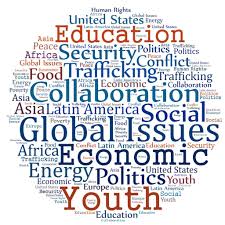15 Innovative Solutions for Global Resource Sustainability

Updated at: 2025-03-01 20:34:46 (8 months ago by Melkisedeck Leon Shine)
Innovative Solutions for Global Resource Efficiency and Conservation
Our planet faces unprecedented challenges related to resource depletion and environmental degradation. The unsustainable consumption patterns of a growing global population demand an urgent shift towards responsible resource management and conservation. Securing essential resources for future generations while safeguarding the environment requires immediate and concerted action. This article explores fifteen key strategies for achieving global sustainable resource utilization and environmental protection, fostering a unified approach to a healthier planet.
Transitioning to Renewable Energy: The reliance on fossil fuels is unsustainable. A rapid transition to renewable energy sources—solar, wind, hydro, and geothermal—is crucial to mitigating climate change and reducing our dependence on finite resources. Investing in renewable energy infrastructure and research will drive innovation and reduce reliance on polluting energy sources.
Revolutionizing Waste Management: Effective waste management is paramount. Implementing comprehensive recycling programs, promoting composting initiatives, and exploring waste-to-energy technologies minimize landfill waste, conserve resources, and reduce greenhouse gas emissions. Investing in innovative waste sorting and processing technologies is essential for maximizing resource recovery.
Promoting Energy Efficiency: Reducing energy consumption through energy-efficient technologies is vital. Incentivizing the adoption of energy-efficient appliances, vehicles, and building designs significantly reduces resource depletion and lowers carbon footprints. Government regulations and consumer education play a critical role in driving this transition.
Sustainable Agricultural Practices: The food system significantly impacts resource utilization. Implementing organic farming methods, promoting agroforestry, and adopting precision agriculture techniques enhance food production while preserving soil health, biodiversity, and water resources. Supporting sustainable farming practices ensures food security and ecological balance.
Conserving Precious Water Resources: Water scarcity is a growing concern. Implementing water-saving technologies, such as drip irrigation and rainwater harvesting, coupled with efficient water management systems, is essential to mitigating water stress and ensuring equitable access to this vital resource. Raising awareness about water conservation practices is equally important.
Reforestation and Afforestation Initiatives: Trees play a vital role in carbon sequestration and ecosystem health. Large-scale afforestation and reforestation efforts, along with the protection of existing forests, are essential for mitigating climate change, conserving biodiversity, and preventing soil erosion. Investing in sustainable forestry practices is critical for long-term ecological stability.
Green Transportation Solutions: The transportation sector contributes significantly to greenhouse gas emissions. Promoting public transportation, cycling, walking, and the adoption of electric vehicles reduces reliance on fossil fuels, decreases air pollution, and enhances urban mobility. Investing in sustainable transportation infrastructure is key.
Sustainable Urban Planning: Urban design significantly impacts resource consumption. Creating green spaces, promoting mixed-use development, investing in efficient public transportation systems, and implementing smart city technologies minimize environmental impact and improve the quality of life for urban dwellers. Sustainable urban planning prioritizes resource efficiency and environmental protection.
Education and Public Awareness Campaigns: Raising awareness about resource efficiency and conservation is paramount. Developing comprehensive educational programs and impactful public awareness campaigns empowers individuals to make informed decisions and adopt sustainable lifestyles. Effective communication is critical in driving behavioral changes.
International Collaboration and Knowledge Sharing: Addressing global challenges requires international cooperation. Collaboration among nations to share best practices, technologies, and funding mechanisms accelerates the implementation of sustainable solutions worldwide. Strengthening international partnerships is crucial for global sustainability.
Supporting Sustainable Businesses: Businesses play a crucial role in driving sustainability. Encouraging businesses to adopt sustainable practices, such as reducing waste, improving energy efficiency, and implementing ethical sourcing, promotes environmental responsibility throughout supply chains. Incentivizing sustainable business practices is key to systemic change.
Advocating for Supportive Policies: Effective environmental policies are crucial for driving sustainability. Advocating for policies that incentivize sustainable practices, regulate pollution, and protect natural resources creates a supportive environment for resource efficiency and conservation. Engaging with policymakers is crucial for influencing legislative change.
Engaging Local Communities: Local communities are essential partners in conservation efforts. Involving local communities in decision-making processes and empowering them to actively participate in resource management leads to more effective and sustainable outcomes. Community engagement fosters ownership and responsibility.
Embracing the Circular Economy: Transitioning to a circular economy, where resources are reused, recycled, and repurposed, minimizes waste and maximizes resource efficiency. Implementing circular economy principles reduces reliance on virgin materials and minimizes environmental impact.
Sustainable Tourism Practices: Tourism can have significant environmental impacts. Promoting responsible tourism practices that minimize environmental footprints, respect local cultures, and support local economies contributes to resource conservation and environmental preservation. Sustainable tourism prioritizes ecological integrity and community well-being.
Conclusion: Achieving global sustainable resource utilization and environmental conservation requires a unified, multi-faceted approach. By implementing these innovative solutions and fostering collaboration among individuals, communities, businesses, and governments, we can build a more sustainable and equitable future for all. Let's work together to protect our planet for generations to come.
What steps will you take to promote global sustainable resource utilization and environmental conservation? Share your thoughts and inspire others to join the movement towards a sustainable future. #SustainableFuture #ResourceConservation #GlobalUnity #TakeAction




